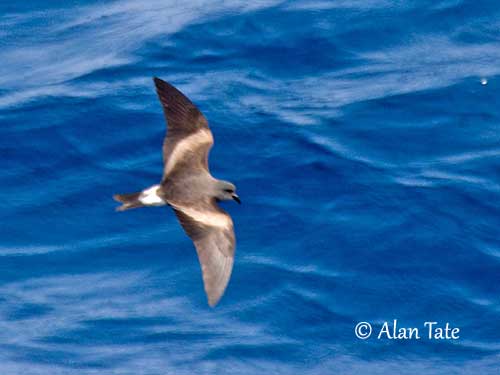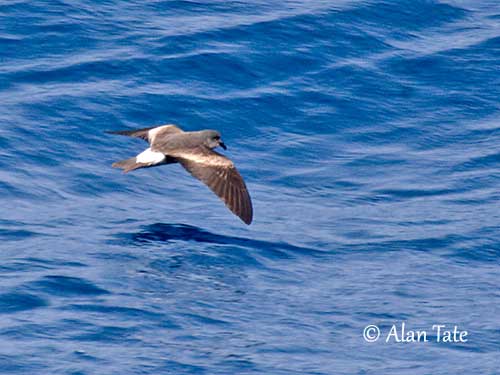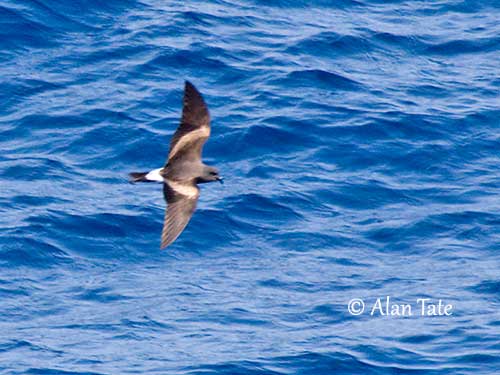
Fr: Océanite cul-blanc
Ang: Leach’s Storm-Petrel
All: Wellenläufer
Esp: Paíño Boreal
Ita: Uccello delle tempeste codaforcuta
Nd: Vaal Stormvogeltje
Sd: Klykstjärtad stormsvala
Photographers:
Alan & Ann Tate
AA Bird Photography
Text by Nicole Bouglouan
Sources:
HANDBOOK OF THE BIRDS OF THE WORLD vol 1 by Josep del Hoyo-Andrew Elliot-Jordi Sargatal - Lynx Edicions - ISBN: 8487334105
THE HANDBOOK OF BIRD IDENTIFICATION FOR EUROPE AND THE WESTERN PALEARCTIC by Mark Beaman, Steve Madge - C. Helm - ISBN: 0713639601
Wikipedia, the free encyclopaedia
What Bird-The ultimate Bird Guide (Mitchell Waite)
Bird Web (Seattle Audubon Society)
Biodiversity Explorer – The Web of Life in Southern Africa
SORA Searchable Ornithological Research Archive (Blair O. Wolf)
Mass Audubon – Protecting the Nature of Massachusetts
Alaska Seabird Information Series
Leach’s Storm-Petrel
Hydrobates leucorhous
Procellariiformes Order – Hydrobatidae Family
INTRODUCTION:
The Leach’s Storm-Petrel is part of the family Hydrobatidae that includes the northern storm-petrels. Its name pays tribute to the British zoologist William Elford Leach.
This species breeds in the colder areas of North Atlantic and North Pacific Oceans, and nests in colonies established on inaccessible islands. Like numerous Procellariiformes, it nests in burrow or rock crevice. It is strictly nocturnal at the breeding sites, in order to avoid predation. It is pelagic outside the breeding season, and migrates to tropical and subtropical seas north of Equator.
The Leach’s Storm-Petrel is vulnerable to oil spills and weather conditions (El Niño), and introduced predators on breeding islands. But currently, the population appears fairly stable.
DESCRIPTION OF THE BIRD:
Biometrics:
Length: 28-22 cm
Wingspan: 45-48 cm
Weight: 38-50 g
The Leach’s Storm-Petrel is brownish-black with a paler panel on the inner part of the upperwing, mostly greyish to pale buff. We can see narrow white fringes on innermost secondaries and longest tertials. The contrasting white rump shows a fine dark median line, visible at close range. The dark tail is deeply forked.
Underparts and underwing are sooty-black, except the white sides of the rump that extends to lateral undertail-coverts and rear of the flanks.
The bill is black, with slightly hooked tip to upper mandible. The eyes are dark brown. Legs and webbed feet are black.
Male and female are similar.
The juvenile resembles adults.

SUBSPECIES AND RANGE:
The Leach’s Storm-Petrel has four subspecies that differ in size and colour of the rump. The frequency of birds with dark rump increases N-S in E Pacific.
H.l. leucorhoa (described above and displayed) occurs mainly in N Pacific and N Atlantic Oceans. This race breeds in N Pacific from NE Japan, N and E through Kuril and Aleutian Islands to S Alaska, and SE to S California and Coronado Islands in NW Mexico. It also breeds in N Atlantic from NE USA and E Canada, E to Iceland, Faeroe Islands, N Scotland and NW Norway. This race has been reported breeding on Dyer Island off South Africa since 1995.
H.l. chapmani occurs in EC Pacific Ocean. It breeds on San Benito and Coronado Islands, off NW Mexico.
This race has usually dark rump, less pointed wings and more deeply forked tail.
H.l. socorroensis or Townsend’s Storm-Petrel occurs in EC Pacific Ocean and breeds in summer on islets by Guadalupe Island off NW Mexico.
This race may have the white rump but narrower at centre or sometimes divided into two large lateral patches.
H.l. cheimomnestes or Ainley’s Storm-Petrel is found in EC Pacific Ocean and breeds in winter on Guadalupe Island, off NW Mexico.
This race has usually white rump.
HABITAT:
The Leach’s Storm-Petrel breeds in remote sites including offshore islands and islets where the colonies are established. It nests in burrow excavated in island soil, or in rock crevice or natural holes.
Outside the breeding season, it can be found in open ocean, concentrating around cold upwellings and areas when cold and warm currents are meeting.
This species forages far out to sea, but also over the continental shelf.
CALLS AND SONGS: SOUNDS BY XENO-CANTO
The Leach’s Storm-Petrel is usually silent at sea, and becomes more vocal at colonies. A prolonged purring is uttered inside the burrow “r-r-r-r-r-r-r-r-r-r-r-r…” rising in pitch and ending with a short “whee” before to repeat this sound at lower pitch.
It also produces a harsh muffled laughing or screaming “par-kiki-kar-koo whuk-kuk-kuh-kuh-kuh”. The bird makes brief pauses between the phrases. These sounds are uttered in flight over the colonies, or inside the burrow.

BEHAVIOUR IN THE WILD:
The Leach’s Storm-Petrel feeds mainly on small crustaceans such as shrimps of genus Euphausia, amphipods, copepods, spiny lobster larvae, small squid and small fish.
It forages by hovering or skimming over the sea surface. It performs the typical pattering behaviour for long periods, hanging almost motionless into the wind with slightly raised wings, while feet are pattering on the water. It also hovers low over the surface, but rarely alights and never dives.
It is both diurnal and nocturnal feeder. It may associate with marine mammals that drive the preys to the surface, but it is usually solitary or in small groups. It rarely follows ships. It feeds in cold upwelling areas with high plankton density, near the edge of the continental shelf.
The Leach’s Storm-Petrel is a colonial breeder and nests in excavated burrow on islands or islets. The nuptial displays usually include aerial pursuits with birds flying in circles above the breeding sites while calling loudly. They fly at great speed in almost total darkness. They are monogamous and most of the sexual activity of a pair occurs inside the burrow and consists of mutual preening, caressing, bill touching and calling. Both mates also engage in prolonged duets in the nest-hole. The copulation takes place on the ground, and often inside the burrow.
The Leach’s Storm-Petrel is migratory and the northern populations migrate S into tropical and subtropical seas. This species is pelagic and comes ashore only for breeding or during storms with strong winds.
The birds start moving S in September until November towards tropics. The return movements start in March until May.
The Leach’s Storm-Petrel has bounding and erratic flight, with frequent changes of direction and speed.

REPRODUCTION OF THIS SPECIES:
The breeding season varies with the range and the subspecies. They breed in summer between May/June and October/November, except the race “cheimomnestes” that breeds in winter from November/December to April/May. The colonies are established on coasts and offshore islands and islets.
The nest-burrow is often under grass, rocks or tree roots. The male excavates the burrow with its bill and feet. These birds often nest close to each other and several burrow entrances can be very close together, or other pairs nest in side branches of one burrow. Rock crevices and natural holes can be used too. The nest-chamber is lined with vegetation such as leaves and grass.
The female lays a single white egg with some purplish dots on the larger end. Both adults incubate during 38-46 days (41-43 days in average). The chick is fed by regurgitation at night. It fledges about 60-70 days after hatching. It will be sexually mature at 5 years old.
PROTECTION / THREATS / STATUS:
The Leach’s Storm-Petrel is vulnerable to predation on its breeding islands, mainly by introduced rats, mice, cats, minks, foxes and otters, but also gulls and skuas. Predators are responsible for local declines. But this species has wide range.
The global population is estimated to number 20,000,000 individuals and is relatively stable.
The Leach’s Storm-Petrel is currently evaluated as Least Concern.